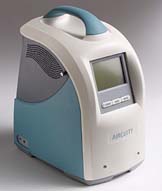
1. A portable monitor, which features nine different sensors to monitor temperature, humidity, carbon monoxide, carbon dioxide, airborne particles, organic compounds, radon, ozone; the unit can also sample mold and pollen.
2. A Web-based information management system, which collects and analyzes all monitoring data.
3. Comprehensive reports, which are generated from the building data and come complete with suggestions for corrective action.
"We offer the means to optimize facility performance," said David Rielly, Aircuity's vice president of marketing. "Facility managers can lower the overall total cost of ownership. We use information from our reports to understand how each building operates.
"We take a holistic approach at reviewing information that is gathered by the Optima monitor to give a broad view of how that information correlates to how well the building is or is not operating. It's not simply the data that is important, but the knowledge and insight generated by the data."
Rielly said that the Optima system measures a lot of parameters that building owners used to take for granted but are now finding increasingly important. "Years ago, if you were too hot, too cold, or too drafty, it was simply considered a temperature control problem, and you might bring in a building maintenance person to adjust the thermostat. "Now that whole concept of too hot, too cold, or too drafty is treated as an IAQ problem."
But there are many other factors besides temperature that affect indoor comfort and system efficiency. Rielly said that the Optima does sample for mold, which gives an indication of how well a building is operating.
"Mold is not used as our focus measure," he said. "We have nine parameters that we measure, and mold can be used as a flag for a problem in the building."
Rielly stated that based on his company's knowledge of indoor air problems and solutions, as well as the collective knowledge of industry experts and partners such as Environmental Health and Engineering, Newton, Mass., a comprehensive report is generated, offering suggestions and solutions to enhance the facility's performance.
The reports are designed to be easy to understand and meaningful to those responsible for building operations, said Rielly.
According to the company, reports can be used for many applications, including optimizing HVAC system performance, reducing energy costs related to over-ventilation, and performing ongoing preventive maintenance. They can also be used for mold assessment and prevention programs, construction and renovation monitoring, and building commissioning.
Each report features detailed graphics, a one-page executive summary, tabular and written evaluations, and practical, customized recommendations.
"Professionals use the system not necessarily because there is a problem. They simply want to know how their building is operating and how they can optimize the operation."
Rielly said that by analyzing facility operations, building owners can optimize efficiency, save on energy costs, and avoid potential problems.
For more information, visit www.aircuity.com.
Publication date: 12/22/2003

Report Abusive Comment